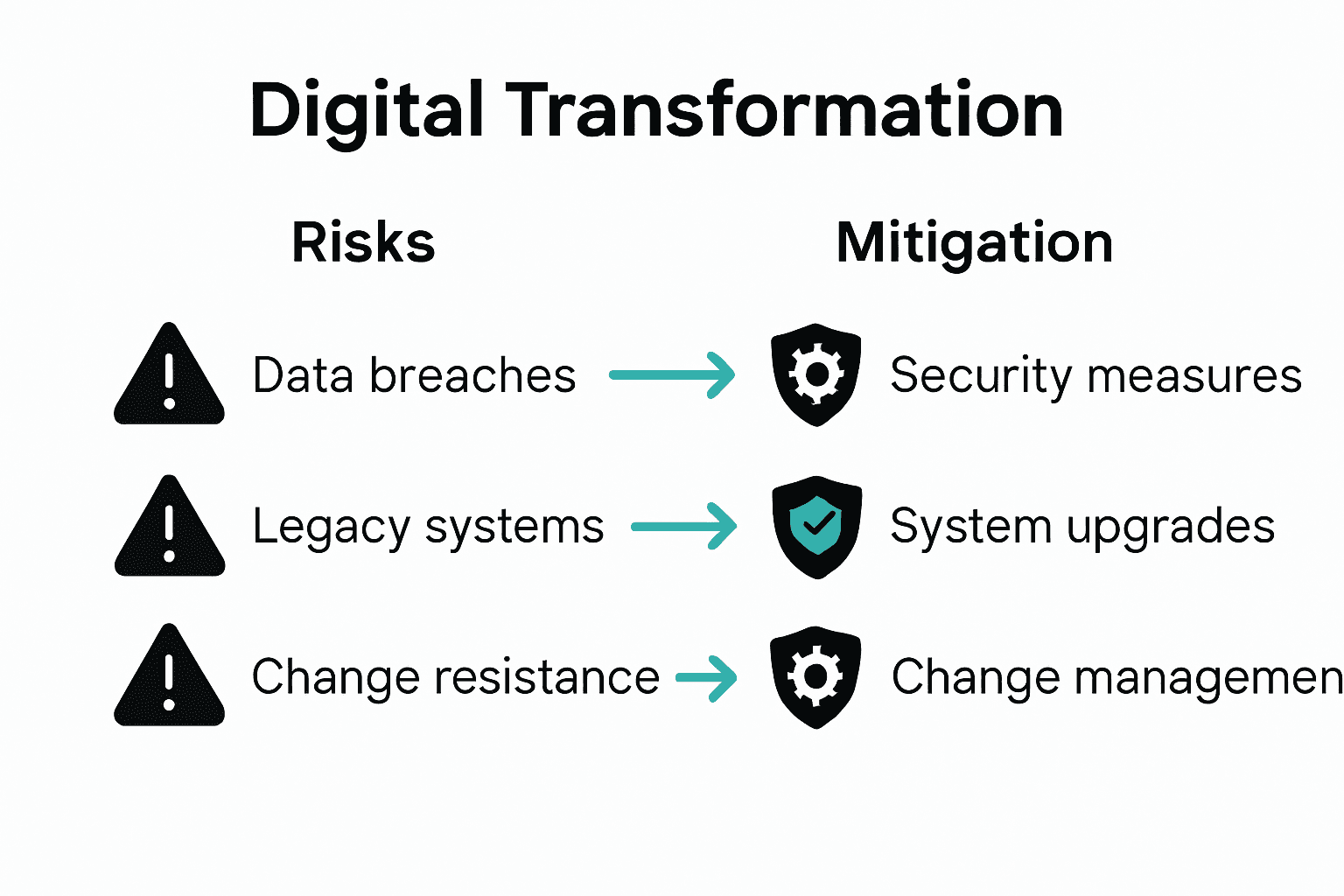Over $2 trillion is projected to be spent on digital transformation worldwide in just a few years. Companies everywhere are moving fast to keep up with digital disruption, searching for smarter ways to connect, operate, and compete. Understanding this shift is no longer optional. Unpacking the strategies and technologies behind business digital transformation reveals why adaptability and innovation now decide who leads in every industry.
Key Takeaways
| Point | Details |
|---|---|
| Holistic Approach to Transformation | Digital transformation must integrate technology across all business units and involve ongoing adaptation rather than a one-time project. |
| Cultural Shift is Essential | Companies need to nurture a culture of continuous learning and experimentation to fully leverage digital innovation. |
| Assess Current State and Future Trends | Organizations should evaluate their existing technologies, identify challenges, and anticipate industry changes to define effective digital strategies. |
| Mitigate Risks Proactively | Planning for budget overruns, change management, and vendor dependence is crucial for the successful execution of digital transformation initiatives. |
Table of Contents
- Defining Business Digital Transformation Today
- Types of Digital Transformation Strategies
- Key Technologies Powering Digital Transformation
- Workflow Automation and Pdf Process Integration
- Risks, Costs, and Common Implementation Pitfalls
Defining Business Digital Transformation Today
Digital transformation represents a profound organizational shift where businesses leverage digital technologies to fundamentally reimagine their operations, customer interactions, and value delivery. Learn more about digital transformation strategies by exploring how modern enterprises are adapting to technological change.
According to research from Wikipedia, digital transformation is “the process by which organizations adopt and implement digital technology to create new or modify existing products, services, and operations, with the goal of increasing value through innovation, improved customer experience, and efficiency.” This definition captures the multifaceted nature of digital transformation, which goes beyond simply implementing new technologies.
Key characteristics of successful digital transformation include:
- Holistic technological integration across all business units
- Strategic realignment of business processes
- Continuous innovation and adaptability
- Enhanced data-driven decision making
- Improved customer and employee experiences
Research from academic sources highlights that business architecture plays a critical role in transformation success. According to an advanced study, effective alignment of business architecture significantly improves efficiency, service delivery, and strategic outcomes. This means organizations must view digital transformation not as a one-time project, but as an ongoing journey of strategic technological evolution.
Successful digital transformation requires more than technological investment—it demands a comprehensive cultural shift. Businesses must cultivate an environment of continuous learning, experimentation, and adaptive thinking to truly harness the potential of digital technologies.
Types of Digital Transformation Strategies
Digital transformation is not a one-size-fits-all approach. Explore comprehensive document transformation techniques to understand how diverse strategies can be tailored to specific organizational needs.
According to research from enterprise strategic development experts, organizations should begin their digital transformation journey by thoroughly investigating three critical areas:
- Current Organizational Status: Comprehensive assessment of existing technological infrastructure
- Existing Business Challenges: Identifying operational bottlenecks and inefficiencies
- Future Industry Trends: Anticipating technological disruptions and market shifts
From a strategic planning perspective, successful digital transformation requires:
- Defining clear, measurable business goals
- Creating phased implementation timelines
- Allocating appropriate resources
- Conducting comprehensive risk assessments
- Establishing performance evaluation metrics
Research from corporate finance perspectives reveals that digital transformation strategies involve multiple complex dimensions. These include:
- Qualitative Measurements: Cultural readiness, employee adaptability
- Quantitative Measurements: Financial metrics, performance indicators
- Internal Impact Factors: Organizational structure, technological capabilities
- External Impact Factors: Market competition, technological innovations
The economic consequences of digital transformation strategies are multifaceted, encompassing investment strategies, financing mechanisms, and potential impacts on overall firm value. Organizations must approach digital transformation as a strategic, holistic process that goes beyond mere technological implementation.
Ultimately, successful digital transformation demands a dynamic, adaptable approach that balances technological innovation with strategic organizational development.
Key Technologies Powering Digital Transformation
Learn about cutting-edge project management technologies that are revolutionizing business digital transformation strategies in the modern enterprise landscape.
According to research from industry thought leaders, digital transformation in 2025 is characterized by creating data-driven, agile ecosystems that fundamentally reimagine how businesses operate. This transformation goes far beyond traditional technological upgrades, focusing instead on comprehensive organizational reinvention.
Key technologies driving digital transformation include:
- Artificial Intelligence (AI): Enabling intelligent decision-making and predictive analytics
- Machine Learning: Facilitating adaptive and self-improving systems
- Cloud Computing: Providing scalable and flexible infrastructure
- Internet of Things (IoT): Connecting and optimizing physical and digital environments
- Robotic Process Automation (RPA): Streamlining repetitive business processes
Research indicates that AI-driven digital transformation has significant performance implications. Specifically, studies demonstrate that human-AI collaboration can positively moderate both direct and indirect performance outcomes. This suggests that the most successful digital transformations will not replace human workers, but rather augment their capabilities through intelligent technological integration.
Emergent digital transformation strategies prioritize several critical elements:
- Creating adaptive, responsive business models
- Leveraging data for strategic decision-making
- Embracing platform-based technological ecosystems
- Focusing on customer-centric experiences
- Integrating sustainability into technological innovation
The future of digital transformation is not just about implementing new technologies, but about creating intelligent, responsive, and sustainable organizational ecosystems that can rapidly adapt to changing market conditions.
Here’s a summary of key technologies driving digital transformation:
| Technology | Main Purpose | Key Benefits |
|---|---|---|
| Artificial Intelligence (AI) | Intelligent decision-making | Predictive analytics Process automation |
| Machine Learning | Self-improving systems | Deeper data insights Adaptive processes |
| Cloud Computing | Scalable infrastructure | Flexibility Reduced IT costs |
| Internet of Things (IoT) | Connectivity | Real-time data Process optimization |
| Robotic Process Automation (RPA) | Automate repetitive tasks | Increased efficiency Reduced errors |
Workflow Automation and PDF Process Integration
Discover advanced PDF workflow automation strategies that transform how enterprises manage and optimize their document processes.
Workflow automation represents a critical frontier in digital transformation, particularly when it comes to document management and PDF processing. According to research, enterprises must move beyond traditional document handling to create more secure, integrated, and efficient workflows.
Key components of modern PDF workflow integration include:
- Standardized Process Definitions: Utilizing XML standards like XPDL to enable seamless workflow interoperability
- Security Enhancement: Implementing robust encryption and access control mechanisms
- Digital Signature Integration: Ensuring document authenticity and non-repudiation
- Comprehensive Tracking: Monitoring document lifecycles from creation to archival
- Automated Processing: Reducing manual interventions and potential human errors
According to technical research, modern enterprises face significant challenges with legacy PDF management.
 The critical focus has shifted towards creating comprehensive security frameworks that protect documents throughout their entire lifecycle. This means going beyond simple file storage to implementing:
The critical focus has shifted towards creating comprehensive security frameworks that protect documents throughout their entire lifecycle. This means going beyond simple file storage to implementing:
- Advanced encryption protocols
- Granular access control mechanisms
- Real-time document tracking
- Automated compliance checks
- Secure digital signature implementation
The XPDL standard plays a crucial role in this transformation, offering an XML-based approach to capturing both graphical and executable aspects of workflow diagrams. This enables businesses to create more flexible, integrated document processing systems that can adapt to changing organizational needs.
Successful workflow automation is not just about technology implementation—it’s about creating intelligent, secure, and adaptable document ecosystems that enhance organizational efficiency and protect critical business information.
Risks, Costs, and Common Implementation Pitfalls
Learn about strategic approaches to mitigating digital transformation risks and navigate the complex landscape of technological change with confidence.
Digital transformation presents organizations with numerous potential challenges that can derail even the most well-intentioned initiatives. Scope creep and budget overruns represent significant risks that can emerge when organizations lack a comprehensive digital maturity assessment and fail to establish clear, defined project boundaries.
Key risks in digital transformation include:
- Vendor Lock-in: Becoming overly dependent on specific technological ecosystems
- Budget Overruns: Unexpected costs that extend beyond initial project estimates
- Operational Disruption: Potential interruptions to existing business processes
- Technology Misalignment: Implementing solutions that don’t match organizational needs
- Change Management Challenges: Resistance from employees and stakeholders
Research indicates that digital transformation projects can be extraordinarily complex, with implementation costs potentially escalating dramatically. According to industry studies, transformation initiatives can exceed original budgets by 50% to 300%, creating significant financial and operational strain.
Critical strategies for risk mitigation include:

- Conducting thorough digital maturity assessments
- Establishing clear, measurable project scopes
- Creating flexible implementation timelines
- Developing comprehensive change management plans
- Building contingency budgets for unexpected challenges
Successful digital transformation requires a holistic approach that balances technological innovation with strategic financial planning. Organizations must remain adaptable, anticipate potential challenges, and maintain a realistic understanding of the comprehensive costs and potential disruptions associated with major technological transitions.
Power Your Digital Transformation With Mapsoft’s Advanced PDF Automation Solutions
Are you facing challenges integrating secure, efficient PDF workflows into your digital transformation strategy? The article highlights pain points like legacy document management, workflow automation gaps, and the struggle to protect and optimize data as you modernize. If you recognize risks such as operational slowdowns, security concerns, or lost efficiency with manual PDF handling, you are not alone.

Mapsoft.com delivers specialized PDF workflow automation and custom Adobe integration solutions. Empower your teams to:
- Standardize document processes effortlessly
- Automate repeated tasks with batch workflow builders
- Secure sensitive files and streamline compliance
If accelerating your digital journey and eliminating productivity roadblocks matter to you, now is the time to act. Visit Mapsoft.com to discover the tools and expertise to future-proof your business document ecosystem and see immediate results.
Frequently Asked Questions
What is business digital transformation?
Digital transformation is the process by which organizations adopt and implement digital technology to modify existing products, services, and operations to increase value through innovation and improved customer experience.
What are the key technologies driving digital transformation?
Key technologies include Artificial Intelligence (AI), Machine Learning, Cloud Computing, Internet of Things (IoT), and Robotic Process Automation (RPA), each contributing to smarter, more efficient business operations and decision-making.
What are some common risks associated with digital transformation?
Common risks include vendor lock-in, budget overruns, operational disruptions, technology misalignment, and challenges in change management, which can impact the success of digital transformation initiatives.
How can businesses assess their current digital maturity?
Businesses can assess their digital maturity by evaluating their existing technological infrastructure, identifying operational bottlenecks, and understanding current market trends to create a comprehensive strategy for digital transformation.



